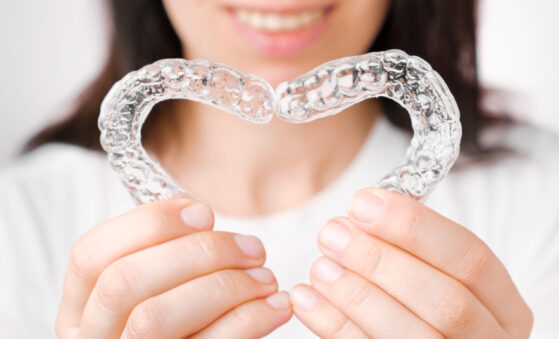Common Challenges with Clear Aligners & How to Overcome Them
Clear aligners are a game-changer in orthodontics. They straighten teeth without the hassle of metal brackets. But, like any dental treatment, they come with their own set of challenges.
If you’re thinking about getting clear aligners or already using them, you might have some concerns. Let’s break down the most common issues and how to deal with them like a pro.
1. Discomfort and Soreness
When you first start wearing clear aligners, your teeth might feel sore. That’s because they’re moving into the right position.
How to Fix It:
- Stick to soft foods for the first few days.
- Use a cold compress to reduce discomfort.
- Over-the-counter pain relievers can help if needed.
- Keep wearing them! The soreness usually goes away after a few days.
2. Difficulty Speaking Clearly
Your tongue needs time to adjust to the new aligners. You might notice a slight lisp in the beginning.
How to Fix It:
- Read out loud for practice.
- Slow down when talking.
- The more you wear them, the faster your speech improves.
3. Keeping Aligners Clean
Aligners can get cloudy or smell bad if you don’t clean them properly.
How to Fix It:
- Rinse them every time you take them out.
- Use a soft toothbrush and clear soap to clean them.
- Avoid colored toothpaste; it can stain them.
- Never use hot water—it can warp them.
4. Losing or Breaking Clear Aligners
Because aligners are removable, they can be misplaced or broken easily.
How to Fix It:
- Always keep them in a case when not in use.
- Avoid wrapping them in napkins; they might get thrown away.
If you lose one, contact your dentist immediately.
5. Feeling Like You Have Too Much Saliva
Your mouth sees the aligners as a foreign object and produces extra saliva.
How to Fix It:
- Give it time—your mouth will adjust in a few days.
- Sip water frequently to manage excess saliva.
6. Staining and Discoloration
Drinking coffee, tea, or wine while wearing aligners can stain them.
How to Fix It:
- Remove aligners when drinking anything except water.
- Brush your teeth before putting them back in.
- Clean them regularly to keep them clear.
7. Not Wearing Them Long Enough
Aligners only work if you wear them for the recommended 20-22 hours per day. Skipping hours can slow down progress.
How to Fix It:
- Set reminders on your phone.
- Only remove them when absolutely necessary.
- Stick to your treatment schedule.
8. Difficulty Removing Aligners
At first, taking aligners out can feel tricky, especially when they fit snugly.
How to Fix It:
- Use your fingertips to gently lift them from the back teeth.
- Try using an aligner removal tool for better grip.
- Don’t rush—slowly work them off instead of forcing them.
9. Dry Mouth or Bad Breath
Wearing aligners can trap bacteria, leading to dryness or bad breath.
How to Fix It:
- Drink plenty of water throughout the day.
- Brush and floss regularly.
- Avoid sugary or acidic drinks.
10. Forgetting to Switch to the Next Set
Clear aligners work in stages. Each new set helps shift your teeth further. Missing a switch can delay progress.
How to Fix It:
- Mark your calendar with your switch dates.
- Keep extra aligners handy if you travel.
- Follow your dentist’s instructions carefully.
Transform Your Smile with Elite Smile Family Dentistry
At Elite Smile Family Dentistry, we provide expert guidance throughout your clear aligner journey. Our team ensures you get the best results with minimal hassle. If you’re ready for a confident smile, book a consultation today!
Your dream smile is just an appointment away!
Final Thoughts
Clear aligners are an excellent way to achieve a straighter smile, but they require care and commitment. If you stay on top of these common challenges, your treatment will be smooth and successful.
FAQs About Clear Aligners
Do clear aligners actually work?
Yes! Clear aligners are highly effective in straightening teeth when worn correctly. They gradually move your teeth into the desired position using gentle pressure. Many people see noticeable results within a few months.
How much do clear aligners cost?
The cost of clear aligners depends on the complexity of your case and the brand you choose. On average, treatment can range from $2,000 to $8,000. Some dental insurance plans cover part of the cost.
Why do dentists not recommend Invisalign?
Most dentists actually do recommend Invisalign, but in some cases, they might suggest traditional braces instead. This happens when a patient has severe misalignment, complex bite issues, or needs more control over tooth movement. Invisalign works best for mild to moderate cases.


